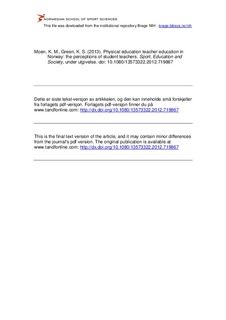| dc.contributor.author | Moen, Kjersti Mordal | |
| dc.contributor.author | Green, Kenneth Stanley | |
| dc.date.accessioned | 2014-03-19T08:54:21Z | |
| dc.date.available | 2014-03-19T08:54:21Z | |
| dc.date.issued | 2012-09-10 | |
| dc.identifier.citation | Sport, Education and Society. 2013, under utgivelse. doi:10.1080/13573322.2012.719867 | nb_NO |
| dc.identifier.uri | http://hdl.handle.net/11250/192630 | |
| dc.description | I Brage finner du siste tekst-versjon av artikkelen, og den kan inneholde ubetydelige forskjeller fra forlagets pdf-versjon. Forlagets pdf-versjon finner du på www.tandfonline.com: http://dx.doi.org/10.1080/13573322.2012.719867 / In Brage you'll find the final text version of the article, and it may contain insignificant differences from the journal's pdf version. The original publication is available at www.tandfonline.com: http://dx.doi.org/10.1080/13573322.2012.719867 | nb_NO |
| dc.description.abstract | A feature of academic literature on physical education teacher education (PETE) is the expectation that it can and should impact upon student teachers' beliefs and prospective practices in some significant ways. This is despite research over the last 20 years or more alluding to the apparent failure of PETE to ‘shake or stir’ (Evans et al., 1996) what might be termed the (typically conservative and conventional) pre-dispositions of student and early career PE teachers. In this article, we examine the perceptions of PE student teachers in Norway in order to ascertain just what it is that makes them so resistant to change and, for that matter, such infertile ground for sowing the seeds of reflexivity. The study involved semi-structured interviews with 41 PE student teachers from the three routes through teacher education available at Nord University College (Nord UC). Among the main themes identified in the data were the PE students' perceptions of: the purposes (and ostensible benefits) of school PE and PETE as well as the nature of PETE itself (including subsidiary themes of sporting and teaching skills, other ‘competencies’, school placements, mentoring and mentors, PETEs' (physical education teacher educators) teaching styles and the students teachers' relationships with the PETEs). The article concludes that, as far as the students at Nord UC were concerned, the significance of PETE revolved around the programme's efficacy in developing the sporting skills and teaching techniques they viewed as central to their preparation for teaching. The minimal impact of the more theoretical aspects of PETE appeared to be partly attributable to the students' perceptions of PE as synonymous with sport in schools and partly to their particularly pragmatic orientations towards PETE. In this vein, the students viewed experience as the most important, most legitimate ‘evidence’ on which to base their beliefs and practices and were resistant to the ‘theory’ of teacher education, rationalising their tendencies to select the evidence that suited them. | nb_NO |
| dc.language.iso | eng | nb_NO |
| dc.publisher | Taylor & Francis | nb_NO |
| dc.subject | VDP::Samfunnsvitenskap: 200::Samfunnsvitenskapelige idrettsfag: 330::Andre idrettsfag: 339 | nb_NO |
| dc.subject | physical education teacher education | nb_NO |
| dc.subject | Norway | nb_NO |
| dc.subject | student teachers | nb_NO |
| dc.title | Physical education teacher education in Norway: The perceptions of student teachers | nb_NO |
| dc.type | Journal article | nb_NO |
| dc.type | Peer reviewed | nb_NO |
| dc.source.journal | Sport, Education and Society | nb_NO |
| dc.identifier.doi | 10.1080/13573322.2012.719867 | |
| dc.description.localcode | Seksjon for kroppsøving og pedagogikk / Department of Physical Education | nb_NO |
